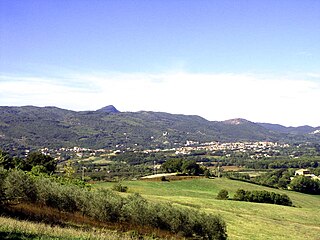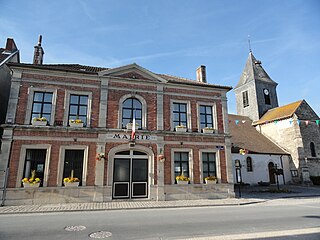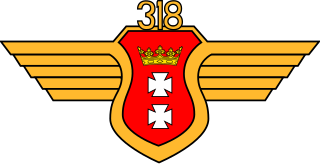
The province of Caserta is a province in the Campania region of Italy. Its capital is the city of Caserta, situated about 36 kilometres (22 mi) by road north of Naples. The province has an area of 2,651.35 square kilometres (1,023.69 sq mi), and had a total population of 924,414 in 2016. The Palace of Caserta is located near to the city, a former royal residence which was constructed for the Bourbon kings of Naples. It was the largest palace and one of the largest buildings erected in Europe during the 18th century. In 1997, the palace was designated a UNESCO World Heritage Site.

Caserta is the capital of the province of Caserta in the Campania region of Italy. An important agricultural, commercial, and industrial comune and city, Caserta is located 36 kilometers north of Naples on the edge of the Campanian plain at the foot of the Campanian Subapennine mountain range. The city is best known for the 18th-century Bourbon Royal Palace of Caserta.

Tiree Airport is located 2.5 nautical miles north northeast of Balemartine on the island of Tiree in the Inner Hebrides off the west coast of Scotland. It is owned and maintained by Highlands and Islands Airports Limited.

No. 683 Squadron RAF was a photo-reconnaissance squadron of the Royal Air Force during the Second World War and from August 1950 to November 1953.
No. 691 Squadron RAF was an Anti-aircraft cooperation squadron of the Royal Air Force from 1943 to 1949.
Royal Air Force Great Massingham or more simply RAF Great Massingham is a former Royal Air Force station located 8.1 miles (13 km) southwest of Fakenham, Norfolk and 11.7 miles (18.8 km) east of King's Lynn, Norfolk, England.

Remote Radar Head Portreath or RRH Portreath is an air defence radar station operated by the Royal Air Force. It has a coastal location at Nancekuke Common, approximately 1.25 kilometres (0.78 mi) north east of the village of Portreath in Cornwall, England.
No. 682 Squadron RAF was a photo reconnaissance squadron of the Royal Air Force during the Second World War.
The Yelahanka Air Force Station is an Indian Air Force airfield in Yelahanka, Bengaluru. The main role of this airfield is to train pilots to fly transport planes. This station also conducts type-conversion of navigators on the Antonov An-32.

Royal Air Force Blakehill Farm or more simply RAF Blakehill Farm is a former Royal Air Force station southwest of Cricklade in Wiltshire, England, operational between 1944 and 1952.
No. 575 Squadron RAF was a transport squadron of the Royal Air Force during the Second World War.

Plivot is a commune in the Marne department in northeastern France.

No. 549 Squadron RAF was a fighter squadron of the Royal Air Force (RAF) operating in Australia from 1943 to 1945.
No. 293 Squadron was a Royal Air Force air-sea rescue squadron. During the Second World War the unit operated search and rescue missions for Allied aircraft operating over Italy.
No. 654 Squadron RAF was a unit of the Royal Air Force during the Second World War. Numbers 651 to 663 Squadrons of the RAF were air observation post units working closely with Army units in artillery spotting and liaison. Their duties and squadron numbers were transferred to the Army with the formation of the Army Air Corps on 1 September 1957.
No. 655 Squadron RAF was a unit of the Royal Air Force during the Second World War. Numbers 651 to 663 Squadrons of the RAF were air observation post units working closely with Army units in artillery spotting and liaison. A further three of these squadrons, 664–666, were manned with Canadian personnel. Their duties and squadron numbers were transferred to the Army with the formation of the Army Air Corps on 1 September 1957.

No. 657 Squadron RAF was a unit of the Royal Air Force in North Africa, Italy and the Netherlands during the Second World War and afterwards in Germany. Numbers 651 to 663 Squadrons of the RAF were air observation post units working closely with British Army units in artillery spotting and liaison. Their duties and squadron numbers were transferred to the Army with the formation of the Army Air Corps on 1 September 1957.
No. 292 Squadron RAF was an air-sea rescue (ASR) squadron of the Royal Air Force operating in the Bay of Bengal during the Second World War.
No. 569 Squadron RAF was a proposed squadron of the Royal Air Force during the Second World War.

No. 318 "City of Gdańsk" Polish Fighter-Reconnaissance Squadron (Polish: 318 Dywizjon Myśliwsko-Rozpoznawczy Gdański") was a Polish tactical reconnaissance aircraft squadron formed in Great Britain as part of an agreement between the Polish Government in Exile and the United Kingdom in 1940. It was one of several Polish squadrons fighting alongside the Royal Air Force (RAF) during World War II.













